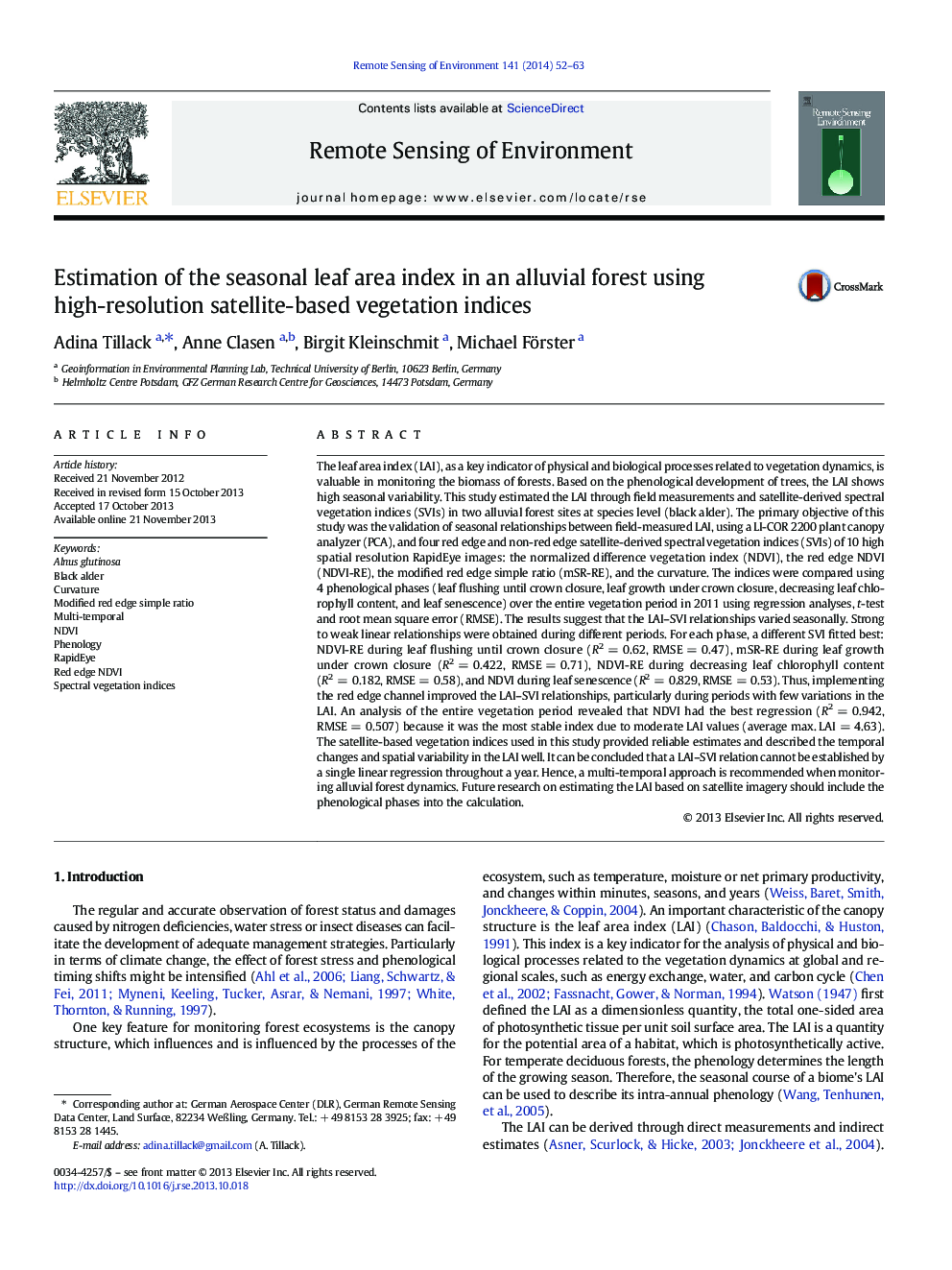| کد مقاله | کد نشریه | سال انتشار | مقاله انگلیسی | نسخه تمام متن |
|---|---|---|---|---|
| 6346811 | 1621259 | 2014 | 12 صفحه PDF | دانلود رایگان |
عنوان انگلیسی مقاله ISI
Estimation of the seasonal leaf area index in an alluvial forest using high-resolution satellite-based vegetation indices
ترجمه فارسی عنوان
برآورد شاخص سطح برگ فصلی در جنگل آبرفتی با استفاده از شاخص های پوشش گیاهی با وضوح بالا
دانلود مقاله + سفارش ترجمه
دانلود مقاله ISI انگلیسی
رایگان برای ایرانیان
کلمات کلیدی
موضوعات مرتبط
مهندسی و علوم پایه
علوم زمین و سیارات
کامپیوتر در علوم زمین
چکیده انگلیسی
The leaf area index (LAI), as a key indicator of physical and biological processes related to vegetation dynamics, is valuable in monitoring the biomass of forests. Based on the phenological development of trees, the LAI shows high seasonal variability. This study estimated the LAI through field measurements and satellite-derived spectral vegetation indices (SVIs) in two alluvial forest sites at species level (black alder). The primary objective of this study was the validation of seasonal relationships between field-measured LAI, using a LI-COR 2200 plant canopy analyzer (PCA), and four red edge and non-red edge satellite-derived spectral vegetation indices (SVIs) of 10 high spatial resolution RapidEye images: the normalized difference vegetation index (NDVI), the red edge NDVI (NDVI-RE), the modified red edge simple ratio (mSR-RE), and the curvature. The indices were compared using 4 phenological phases (leaf flushing until crown closure, leaf growth under crown closure, decreasing leaf chlorophyll content, and leaf senescence) over the entire vegetation period in 2011 using regression analyses, t-test and root mean square error (RMSE). The results suggest that the LAI-SVI relationships varied seasonally. Strong to weak linear relationships were obtained during different periods. For each phase, a different SVI fitted best: NDVI-RE during leaf flushing until crown closure (R2Â =Â 0.62, RMSEÂ =Â 0.47), mSR-RE during leaf growth under crown closure (R2Â =Â 0.422, RMSEÂ =Â 0.71), NDVI-RE during decreasing leaf chlorophyll content (R2Â =Â 0.182, RMSEÂ =Â 0.58), and NDVI during leaf senescence (R2Â =Â 0.829, RMSEÂ =Â 0.53). Thus, implementing the red edge channel improved the LAI-SVI relationships, particularly during periods with few variations in the LAI. An analysis of the entire vegetation period revealed that NDVI had the best regression (R2Â =Â 0.942, RMSEÂ =Â 0.507) because it was the most stable index due to moderate LAI values (average max. LAIÂ =Â 4.63). The satellite-based vegetation indices used in this study provided reliable estimates and described the temporal changes and spatial variability in the LAI well. It can be concluded that a LAI-SVI relation cannot be established by a single linear regression throughout a year. Hence, a multi-temporal approach is recommended when monitoring alluvial forest dynamics. Future research on estimating the LAI based on satellite imagery should include the phenological phases into the calculation.
ناشر
Database: Elsevier - ScienceDirect (ساینس دایرکت)
Journal: Remote Sensing of Environment - Volume 141, 5 February 2014, Pages 52-63
Journal: Remote Sensing of Environment - Volume 141, 5 February 2014, Pages 52-63
نویسندگان
Adina Tillack, Anne Clasen, Birgit Kleinschmit, Michael Förster,
